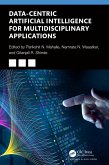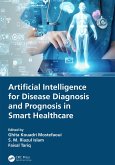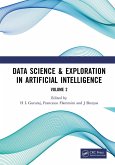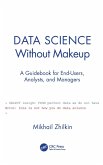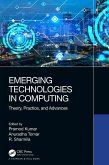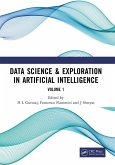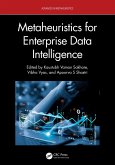Smart Applications of Artificial Intelligence and Big Data (eBook, PDF)
Redaktion: Belaqziz, Salwa; Ullah Khan, Inam; Abdellah, Boulouz; Koutti, Lahcen; Lahmyed, Redouan; Amellal, Hicham; Hajjami, Salma El


Alle Infos zum eBook verschenken

Smart Applications of Artificial Intelligence and Big Data (eBook, PDF)
Redaktion: Belaqziz, Salwa; Ullah Khan, Inam; Abdellah, Boulouz; Koutti, Lahcen; Lahmyed, Redouan; Amellal, Hicham; Hajjami, Salma El
- Format: PDF
- Merkliste
- Auf die Merkliste
- Bewerten Bewerten
- Teilen
- Produkt teilen
- Produkterinnerung
- Produkterinnerung

Hier können Sie sich einloggen

Bitte loggen Sie sich zunächst in Ihr Kundenkonto ein oder registrieren Sie sich bei bücher.de, um das eBook-Abo tolino select nutzen zu können.
Smart Applications of Artificial Intelligence and Big Data covers a wide range of topics related to AI and big data, including machine learning, deep learning, natural language processing, computer vision, data analytics, and data mining. It focuses on the integration of these technologies to create smart applications, such as intelligent transportation systems, smart healthcare, smart cities, and smart grids.
This book comprises 21 chapters, each providing technical details pertaining to research, practical examples, and case studies to help readers understand the real-world applications…mehr
- Geräte: PC
- mit Kopierschutz
- eBook Hilfe
- Größe: 17.62MB
![Data-Centric Artificial Intelligence for Multidisciplinary Applications (eBook, PDF) Data-Centric Artificial Intelligence for Multidisciplinary Applications (eBook, PDF)]() Data-Centric Artificial Intelligence for Multidisciplinary Applications (eBook, PDF)52,95 €
Data-Centric Artificial Intelligence for Multidisciplinary Applications (eBook, PDF)52,95 €![Artificial Intelligence for Disease Diagnosis and Prognosis in Smart Healthcare (eBook, PDF) Artificial Intelligence for Disease Diagnosis and Prognosis in Smart Healthcare (eBook, PDF)]() Artificial Intelligence for Disease Diagnosis and Prognosis in Smart Healthcare (eBook, PDF)44,95 €
Artificial Intelligence for Disease Diagnosis and Prognosis in Smart Healthcare (eBook, PDF)44,95 €![Data Science & Exploration in Artificial Intelligence (eBook, PDF) Data Science & Exploration in Artificial Intelligence (eBook, PDF)]() Data Science & Exploration in Artificial Intelligence (eBook, PDF)167,95 €
Data Science & Exploration in Artificial Intelligence (eBook, PDF)167,95 €![Data Science Without Makeup (eBook, PDF) Data Science Without Makeup (eBook, PDF)]() Mikhail ZhilkinData Science Without Makeup (eBook, PDF)25,95 €
Mikhail ZhilkinData Science Without Makeup (eBook, PDF)25,95 €![Emerging Technologies in Computing (eBook, PDF) Emerging Technologies in Computing (eBook, PDF)]() Emerging Technologies in Computing (eBook, PDF)49,95 €
Emerging Technologies in Computing (eBook, PDF)49,95 €![Data Science & Exploration in Artificial Intelligence (eBook, PDF) Data Science & Exploration in Artificial Intelligence (eBook, PDF)]() Data Science & Exploration in Artificial Intelligence (eBook, PDF)52,95 €
Data Science & Exploration in Artificial Intelligence (eBook, PDF)52,95 €![Metaheuristics for Enterprise Data Intelligence (eBook, PDF) Metaheuristics for Enterprise Data Intelligence (eBook, PDF)]() Metaheuristics for Enterprise Data Intelligence (eBook, PDF)52,95 €
Metaheuristics for Enterprise Data Intelligence (eBook, PDF)52,95 €-
-
-
This book comprises 21 chapters, each providing technical details pertaining to research, practical examples, and case studies to help readers understand the real-world applications of AI and big data technologies. The book also highlights cutting-edge research on AI and big data, including novel algorithms, tools, and techniques. It discusses the challenges and opportunities of using AI and big data to develop smart applications and provides recommendations for the development of responsible and transparent AI-based systems. This book is a valuable resource for researchers and professionals looking to stay up-to-date with the latest advancements in AI and big data and how they can be applied to solve real-world challenges.
Dieser Download kann aus rechtlichen Gründen nur mit Rechnungsadresse in A, B, BG, CY, CZ, D, DK, EW, E, FIN, F, GR, HR, H, IRL, I, LT, L, LR, M, NL, PL, P, R, S, SLO, SK ausgeliefert werden.
- Produktdetails
- Verlag: Taylor & Francis eBooks
- Seitenzahl: 304
- Erscheinungstermin: 30. Juni 2025
- Englisch
- ISBN-13: 9781040350188
- Artikelnr.: 74233192
- Verlag: Taylor & Francis eBooks
- Seitenzahl: 304
- Erscheinungstermin: 30. Juni 2025
- Englisch
- ISBN-13: 9781040350188
- Artikelnr.: 74233192
- Herstellerkennzeichnung Die Herstellerinformationen sind derzeit nicht verfügbar.
implications of container live migration in clouds: An approach performed
on Amazon Web Services (AWS), 2. A deep learning (DL) framework for
gastrointestinal (GI) abnormality classification and localization within
WCE images, 3. Breast cancer segmentation using U-Net and transfer learning
approaches, 4. Transforming graphics processing unit-accelerated machine
learning (ML) environments with Docker Cloud containers, 5. A review of
image-based deep learning approaches for atmospheric visibility estimation,
6. Advancing cloud security: Evaluating interpretable machine learning
algorithms for DDoS attack detection, 7. Classification of gastrointestinal
(GI) bleeding in WCE images based on fusing a stabilizing block with
Xception, 8. Lung tumor recognition and classification in CT scan images
using CNNs, transfer learning, and ensemble learning, 9. A new pedestrian
detection method for intelligent surveillance systems, Part II. Smart
applications, 10.Compensation of harmonic currents for shunt active power
filter using ADALINE neural network, 11. Control of a grid-connected
photovoltaic system based on MPPT and vector control, 12. GeoArgania: A
geolocation mapping dataset of Argania trees in the Souss region, 13. PSM
model for NoSQL key-value databases through model programming, 14. Body
temperature screening during COVID-19 pandemic, 15. Signal processing
system for Heart Rate Extraction via LabVIEW, 16. Investigating the impacts
of COVID-19 over time using sentiment analysis and topic modeling, Part
III. Internet of Things (IoT) and big data, 17. Smart EV routing to
charging stations for traffic optimization in smart cities: A case study in
Agadir, 18. Dual-scored dimensionality reduction and spectral unmixing for
hyperspectral data analysis, 19. Counterfeit medicine detection system, 20.
SDN-enabled intrusion detection system using machine learning and neural
network schemes, 21. Information security awareness in higher education:
The need for a tailor-made suit
implications of container live migration in clouds: An approach performed
on Amazon Web Services (AWS), 2. A deep learning (DL) framework for
gastrointestinal (GI) abnormality classification and localization within
WCE images, 3. Breast cancer segmentation using U-Net and transfer learning
approaches, 4. Transforming graphics processing unit-accelerated machine
learning (ML) environments with Docker Cloud containers, 5. A review of
image-based deep learning approaches for atmospheric visibility estimation,
6. Advancing cloud security: Evaluating interpretable machine learning
algorithms for DDoS attack detection, 7. Classification of gastrointestinal
(GI) bleeding in WCE images based on fusing a stabilizing block with
Xception, 8. Lung tumor recognition and classification in CT scan images
using CNNs, transfer learning, and ensemble learning, 9. A new pedestrian
detection method for intelligent surveillance systems, Part II. Smart
applications, 10.Compensation of harmonic currents for shunt active power
filter using ADALINE neural network, 11. Control of a grid-connected
photovoltaic system based on MPPT and vector control, 12. GeoArgania: A
geolocation mapping dataset of Argania trees in the Souss region, 13. PSM
model for NoSQL key-value databases through model programming, 14. Body
temperature screening during COVID-19 pandemic, 15. Signal processing
system for Heart Rate Extraction via LabVIEW, 16. Investigating the impacts
of COVID-19 over time using sentiment analysis and topic modeling, Part
III. Internet of Things (IoT) and big data, 17. Smart EV routing to
charging stations for traffic optimization in smart cities: A case study in
Agadir, 18. Dual-scored dimensionality reduction and spectral unmixing for
hyperspectral data analysis, 19. Counterfeit medicine detection system, 20.
SDN-enabled intrusion detection system using machine learning and neural
network schemes, 21. Information security awareness in higher education:
The need for a tailor-made suit

